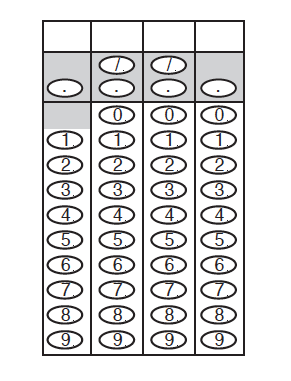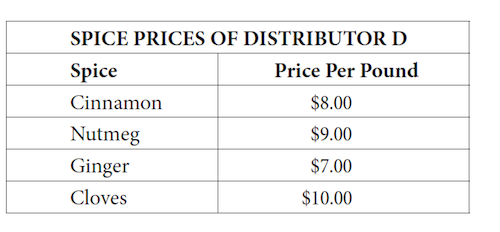You've picked your SAT test date . Are you ready for the math section?
Learn exactly what to expect when you take the SAT and start honing your skills with some SAT math practice. Each sample question includes an explanation, so you can see how to crack it!
SAT Math: What to Study & Review
Here's the 4 categories of math concepts that are tested on the SAT:
- Algebra
- Advanced Math
- Data Analysis & Problem Solving
- Geometry & Trigonometry
That’s it! Of these categories, Algebra and Advanced Math make up the largest part of the test, each delivering up to 15 questions each. Geometry & Trigonometry , and Problem Solving & Data Analysis make up the smallest part—there will only be a maximum of 14 questions total from these two categories on the SAT.
How the Test is Organized
The SAT Math section is made up of two modules organized in the same way. Here's what you can expect on each of them.
| SAT Math Modules |
|---|
| Calculator allowed |
| 35 minutes |
Up to 22 questions:
|

About Grid-ins
Some Math questions will require you to produce your own answers and mark them on a grid shown on your answer sheet.
Although the format of these questions is different from that of the multiple choice questions, the mathematical concepts tested aren’t all that different.
Which SAT math formulas do I need to memorize?
Both SAT Math sections will begin with the same set of instructions. These instructions include a few formulas, like the area and circumference of a circle, that you may need to know in order to answer some of the questions. You should learn these formulas ahead of time so you don’t have to waste valuable time flipping back to them during the test.
What kind of calculator should I bring?
If you have a graphing calculator, great. If you don’t, don’t sweat it! There is a graphing calculator built into the Bluebook applicaiton so you will have one handy should you need it. If you do decide to use a graphing calculator, keep in mind that it cannot have a QWERTY-style keyboard on it (like the TI-95). Also, you can't use the calculator on your phone. On test day, you will have to turn your phone off and put it underneath your seat. To verify that your specific calculator is approved for test day, check the College Board website.
These SAT math questions and explanations come straight from our book SAT Premium Prep .
No Calculator Practice
Work these practice questions without your calculator.
1. 1 ⁄ 8 + 1 ⁄ 10 = a ⁄ b
In the equation above, if a and b are positive integers and a ⁄ b is in its simplest reduced form, what is the value of a?
(A) 2 (B) 9 (C) 18 (D) 40
Answer: (B)
The lowest number that both 8 and 10 are factors of is 40. Convert the fractions to a denominator of 40: 5 ⁄ 40 + 4 ⁄ 40 = 9 ⁄ 40 .There is no factor that 9 and 40 have in common, so the fraction cannot be reduced. The number in place of a in a ⁄ b is 9, so the answer is (B). Be careful! The value of b is in (D).
2. The length of a certain rectangle is twice the width. If the area of the rectangle is 128, what is the length of the rectangle?
(A) 4 (B) 8 (C) 16 (D) 21⅓
Answer: (C)
Plug in the answers. If you start with (B), the length is 8, and the width is half that, or 4. Area is length × width. The area of this rectangle is 8 × 4, which is nowhere near 128. Eliminate (A) and (B), as both are too small. Try (C): If the length is 16, the width is 8. So, does 128 = 16 × 8? You could write it all out, since you can’t use your calculator, but you can also estimate. 16 × 10 = 160, so 16 × 8 would be about 130. The number in (D) is too large and will give a weird fraction, so (C) is correct. Alternatively, write an equation. The equation is area = w × 2w. So, 128 = 2w 2 . Divide by 2 to get 64 = w 2 . Take the square root of both sides to find w = 8. The length is twice this width, so length = 2 × 8 = 16, and the answer is (C).
3. Let the function f be defined such that f(x) = x 2 - c, where c is a constant. If f(−2) = 6, what is the value of c ?
(A) -10 (B) -2 (C) 0 (D) 2
Answer: (B)
Start by plugging in what you know into the function given. If f(x) = x 2 - c, and f(–2) = 6, then plug in –2 for x in the function: f(–2) = (–2) 2 – c. Solve and replace f(–2) with 6: 6 = 4 – c; 2 = –c; and c = –2. If you picked (A), you forgot that (–2) 2 is positive 4.
Calculator Practice
Work these practice questions using your calculator as needed.
4. If a rectangular swimming pool has a volume of 16,500 cubic feet, a uniform depth of 10 feet, and a length of 75 feet, what is the width of the pool, in feet?
(A) 22 (B) 26 (C) 32 (D) 110
Answer: (A)
For this question, you need to know that volume equals length × width × height. You know that the volume is 16,500, the depth (or height) is 10, and the length is 75. Just put those numbers in the formula: 16,500 = 75 × w × 10. Use your calculator to solve for w, which equals 22: (A).
5. Nails are sold in 8-ounce and 20-ounce boxes. If 50 boxes of nails were sold and the total weight of the nails sold was less than 600 ounces, what is the greatest possible number of 20-ounce boxes that could have been sold?
(A) 33 (B) 25 (C) 17 (D) 16
Answer: (D)
To solve this question, plug in the answer choices. The question asks for the greatest possible number of 20-ounce boxes. Start with (B). If there are twenty-five 20-ounce boxes, then there are twenty-five 8-ounce boxes because a total of 50 boxes was purchased. In this case, the twenty-five 20-ounce boxes weigh 500 ounces, and the twenty-five 8-ounce boxes weigh 200 ounces; the total is 700 ounces. This is too big because the question says the total weight was less than 600. If (B) is too big, (A) must also be too big; eliminate both answers. If you try (C), the total weight is 604 ounces, which is still too big. So the answer must be (D).
6.

The owner of a spice store buys 3 pounds each of cinnamon, nutmeg, ginger, and cloves from distributor D. She then sells all of the spices at $2.00 per ounce. What is her total profit, in dollars?
(1 pound = 16 ounces)
(A) $192 (B) $282 (C) $384 (D) $486
Answer: (B)
This is a hard question, so you have to stay on your toes. If the owner buys 3 pounds of each spice, that means she pays the following amounts for each spice:
cinnamon: $8 × 3 = $24
nutmeg: $9 × 3 = $27
ginger: $7 × 3 = $21
cloves: $10 × 3 = $30
So she pays a total of 24 + 27 + 21 + 30, or $102 for 12 pounds of spices. She then sells the spices per ounce , so you have to figure out first how many ounces of spices she has. If 1 pound is 16 ounces, then 12 pounds is 12 × 16, or 192 ounces. She sells all the spices at $2 per ounce, so she makes 192 × $2, or $384. To figure out her profit, subtract the amount she paid for the spices from the amount she made selling them: $384 – $102 = $282, (B).
Build the right SAT prep plan for you
Our private tutors will help you build a prep plan that's customized to your score goals, study habits, and schedule.
Read More
Explore Colleges For You
Connect with our featured colleges to find schools that both match your interests and are looking for students like you.
Get Started on Athletic Scholarships & Recruiting!
Join athletes who were discovered, recruited & often received scholarships after connecting with NCSA's 42,000 strong network of coaches.
Best 390 Colleges
168,000 students rate everything from their professors to their campus social scene.
Explore Colleges For You
Connect with our featured colleges to find schools that both match your interests and are looking for students like you.
Get Started on Athletic Scholarships & Recruiting!
Join athletes who were discovered, recruited & often received scholarships after connecting with NCSA's 42,000 strong network of coaches.
Best 390 Colleges
168,000 students rate everything from their professors to their campus social scene.
Explore Colleges For You
Connect with our featured colleges to find schools that both match your interests and are looking for students like you.
Get Started on Athletic Scholarships & Recruiting!
Join athletes who were discovered, recruited & often received scholarships after connecting with NCSA's 42,000 strong network of coaches.
Best 390 Colleges
168,000 students rate everything from their professors to their campus social scene.



